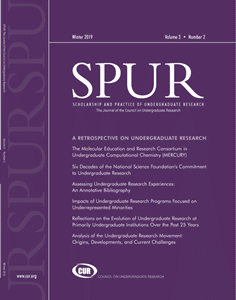SPUR (2019) 3 (2): https://doi.org/10.18833/spur/3/2/8
The national prominence of undergraduate research arises from both the myriad benefits offered for a wide range of stakeholders and the variety of modes in which this scholarly endeavor may be pursued. The evolution of undergraduate research in the United States parallels that of a social movement, with an array of participant entities that aspire to incorporate the research process into undergraduate curricula. Throughout its history, the Council on Undergraduate Research has contributed significantly to the extraordinary development of this form of engaged learning. Although it is thriving, the undergraduate research movement must address emerging as well as potential challenges facing higher education today to continue to flourish and serve greater numbers of students.
More Articles in this Issue
No posts found


